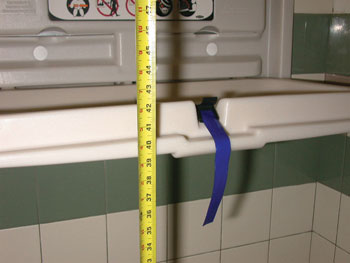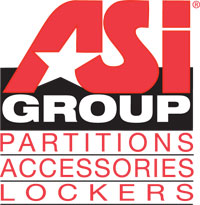A Practical Guide to 2010 ADA-Compliant Restroom Design
Toilet compartment accessories refer to toilet paper dispensers, sanitary napkin disposal units, fold-up shelves and combination units. Remember each accessory in the wheelchair accessible toilet compartment requires a clear floor space minimum of 30 inches by 48 inches. This allows an individual to roll up to the accessory and manipulate it with ease. Partition-mounted combination units are popular, because they combine up to six essential components into one compact, easily installed and easily serviced unit that maximizes clear floor space in small areas, however, the mounting heights of these units need to be carefully detailed, because they can conflict with the grab bars if not correctly installed.
Toilet compartment accessories should be mounted within the reach range established in the 2010 ADA Standard, which mandates that the operable mechanism of the accessory be mounted no lower than 15 inches and no higher than 48 inches AFF.
Please note that in terms of specific placement requirements there can be conflicts between the stipulations in the 2010 ADA Standard and building codes. For example, with regard to toilet paper dispenser placement, the 2009 ICC/ANSI A117.1 details dimensions in terms of the distance from the back wall to the leading edge of the accessory and not from the toilet lip to the accessory centerline, as is stipulated in the 2010 ADA Standard.
LavatoriesA wheelchair accessible sink and counter are perhaps two of the trickiest, or least understood, elements specified in a washroom. There are a number of dimensions that must be considered and correctly specified in order to be sure that a person and their wheelchair can fit comfortably underneath, while keeping the countertop and faucet at an acceptable height. The 2010 ADA Standard states that the sink rim and counter surface should be mounted as not to exceed a 34 inch maximum AFF. While acceptable knee and toe clearance is defined as the vertical space between 9 inches and 27 inches AFF with a minimum depth requirement of 11 inches deep at 9 inches AFF for toes and 8 inches deep at 27 inches AFF for knees. An important product feature of any lavatory specified for a wheelchair accessible application is that it must be less than seven inches thick, so the top of the lip can be mounted at 34 inches and the bottom will not interfere with the knee clearance needed at 27 inches AFF.
The lavatory requires the minimum clear floor space of 30 inches by 48 inches, identical to the clear floor space required by any accessory in the toilet room or lavatory accessory. The clear floor space needed by the sink can go all the way to the wall as long as there is no obstruction.
Lavatory AccessoriesLavatory accessories include paper towel dispensers, soap dispensers, hand dryers, mirrors and waste receptacles. Critical compliance issues that are important to address when specifying and positioning these accessories include: verifying the minimum clear floor space requirements have been met, specifying products with operating mechanisms that do not require grasping, pinching or twisting of the wrist , and ensuring the path of travel is free from protruding objects. It should be noted that many manufacturers are making much thinner hand dryers these days, so the protrusion issue is getting easier to avoid.
 |
|
Photo courtesy of The ASI Group The 2010 ADA Standard requires that highest edge of the changing deck be no higher than 34 inches AFF. The baby changing station shown here is non-compliant. |
The baby changing station is another washroom item that is often found to be non-compliant with ADA regulations. Overwhelmingly, the issue is that the changing station is mounted at an incorrect height. The station must be mounted so that the deck height, when deployed, is between 28 inches and 34 inches AFF. The measurement that must be used to determine deck height is the distance from the floor to the highest edge or lip of the pull-down deck, not the bed of the changing deck. The reason for this is that the deck placement must not require an individual using the changing station to lift a baby any higher than 34 inches AFF. If the baby must be lifted to 35 or 36 inches to get over the lip, the product is not compliant. The highest point on the deck that the child will need to be lifted over is the critical measurement here and it must fall within the 28 to 34 inches range.
In addition to the acceptable height of the deck, the handle that is used to pull the changing station into position cannot exceed the ADA-defined reach range maximum of 48 inches AFF. Depending upon the changing station used, these two requirements, deck height and handle height, can be in conflict with one another. When some products are specified, placing the handle at 48 inches AFF may position the deck lower than the 28 inches AFF minimum that is acceptable. Try to specify a changing station that will not create this issue.
While the 2010 ADA Standard is filled with many specific and highly detailed requirements that must be successfully accommodated in order create a restroom that is ADA compliant, designers have many resources available to them that can provide useful insight. Knowledgeable manufacturers' reps are a good resource to use in order to understand the ADA-specific nuances that apply to their products, helping architects achieve ADA compliance one product at a time.
 |
The ASI Group, whose mission is to make its customers successful by providing value that exceeds price and an excellent service experience, is comprised of four Division 10 manufacturers: American Specialties, Inc., Global Partitions, Accurate Partitions Corp. and ASI Storage Solutions. Together they offer a single-source solution for washroom accessories, toilet partitions, lockers and other storage products. www.asigroup.us |








